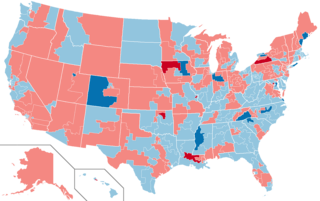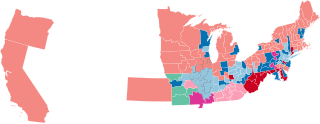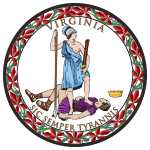
The 2000 United States House of Representatives elections were held on November 7, 2000, to elect U.S. Representatives to serve in the 107th United States Congress. They coincided with the election of George W. Bush as President of the United States. The Republican Party won 221 seats, while the Democratic Party won 212 and independents won two.

The 1986 United States House of Representatives elections was held on November 4, 1986, to elect U.S. Representatives to serve in the 100th United States Congress. They occurred in the middle of President Ronald Reagan's second term in office, while he was still relatively popular with the American public. As in most mid-term elections, the President's party — in this case, the Republican Party — lost seats, with the Democratic Party gaining a net of five seats and cementing its majority. These results were not as dramatic as those in the Senate, where the Republicans lost control of the chamber to the Democrats.

The 1862–63 United States House of Representatives elections were held on various dates in various states between June 2, 1862, and November 3, 1863, during the American Civil War and President Abraham Lincoln's first term. Each state set its own date for its elections to the House of Representatives before the first session of the 38th United States Congress convened on December 7, 1863. The congressional reapportionment based on the 1860 United States Census was performed assuming the seceded states were still in the union, increasing the number of congressional districts to 241. West Virginia was given three seats from Virginia after the former broke away from the latter to rejoin the union as a separate state. The seceded states remained unrepresented and left 58 vacancies. Republicans lost 22 seats and the majority, while Democrats gained 28.

The 2006 United States House of Representatives elections in Virginia were held on November 7, 2006 to determine who will represent the Commonwealth of Virginia in the United States House of Representatives. Virginia has eleven seats in the House, apportioned according to the 2000 United States Census. Representatives are elected for two-year terms.

Virginia's 10th congressional district is a U.S. congressional district in the Commonwealth of Virginia. It is currently represented by Democrat Jennifer Wexton, who was first elected in 2018.

The United States House of Representatives elections in California of 1986 was an election for California's delegation to the United States House of Representatives, which occurred as part of the general election of the House of Representatives on November 4, 1986. No districts switched parties, so the delegation remained at 27 Democrats and 18 Republicans.

The 1980 United States House of Representatives elections in Virginia were held on November 4, 1980 to determine who will represent the Commonwealth of Virginia in the United States House of Representatives. Virginia had ten seats in the House, apportioned according to the 1970 United States Census. Representatives are elected for two-year terms.

The 1930 United States House of Representatives elections in Virginia were held on November 4, 1930 to determine who will represent the Commonwealth of Virginia in the United States House of Representatives. Virginia had ten seats in the House, apportioned according to the 1920 United States Census. Representatives are elected for two-year terms.

The 1952 United States House of Representatives elections in Virginia were held on November 4, 1952 to determine who will represent the Commonwealth of Virginia in the United States House of Representatives. Virginia gained an additional seat, having ten seats in the House apportioned according to the 1950 United States Census. Representatives are elected for two-year terms. Until this election, the Democratic Party had won every seat since 1932.

The 1958 United States House of Representatives elections in Virginia were held on November 4, 1958 to determine who will represent the Commonwealth of Virginia in the United States House of Representatives. Virginia had ten seats in the House, apportioned according to the 1950 United States Census. Representatives are elected for two-year terms.

The 2004 United States House of Representatives elections in Virginia were held on November 2, 2004 to determine who will represent the Commonwealth of Virginia in the United States House of Representatives. Virginia has eleven seats in the House, apportioned according to the 2000 United States Census. Representatives are elected for two-year terms.

The 1988 United States presidential election in Virginia took place on November 8, 1988. All 50 states and the District of Columbia, were part of the 1988 United States presidential election. Virginia voters chose 12 electors to the Electoral College, which selected the president and vice president.

The 1984 United States House of Representatives elections in Virginia were held on November 6, 1984 to determine who will represent the Commonwealth of Virginia in the United States House of Representatives. Virginia had ten seats in the House, apportioned according to the 1980 United States Census. Representatives are elected for two-year terms.

The 1978 United States House of Representatives elections in Virginia were held on November 7, 1978 to determine who will represent the Commonwealth of Virginia in the United States House of Representatives. Virginia had ten seats in the House, apportioned according to the 1970 United States Census. Representatives are elected for two-year terms.

The 1974 United States House of Representatives elections in Virginia were held on November 4, 1974 to determine who will represent the Commonwealth of Virginia in the United States House of Representatives. Virginia had ten seats in the House, apportioned according to the 1970 United States Census. Representatives are elected for two-year terms.

The 1940 United States House of Representatives elections in Virginia were held on November 5, 1940 to determine who will represent the Commonwealth of Virginia in the United States House of Representatives. Virginia had nine seats in the House, apportioned according to the 1930 United States Census. Representatives are elected for two-year terms.

The 1924 United States House of Representatives elections in Virginia were held on November 4, 1924, to determine who will represent the Commonwealth of Virginia in the United States House of Representatives. Virginia had ten seats in the House, apportioned according to the 1920 United States Census. Representatives are elected for two-year terms.
George Washington stood for public office five times, serving two terms in the Virginia House of Burgesses and two terms as President of the United States. He is the only independent elected as U.S. president and the only person unanimously elected to that office.
Donald "Bud" Cook is a Republican member of the Pennsylvania House of Representatives, who has represented the 50th District since 2023. Prior to redistricting, Cook represented the 49th District from 2017 to 2022.

The 1986 United States House of Representatives election in Wyoming was held on November 4, 1986. Incumbent Representative Dick Cheney defeated Rick Gilmore with 69.28% of the vote.







